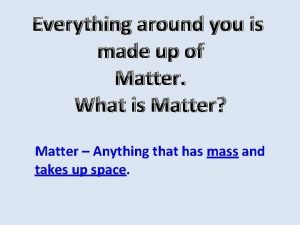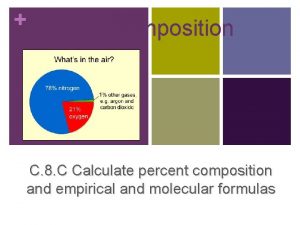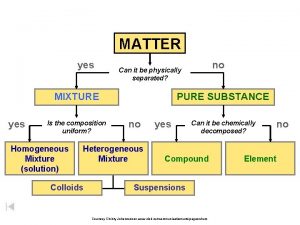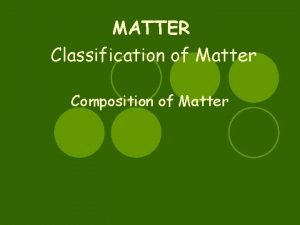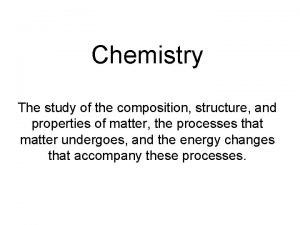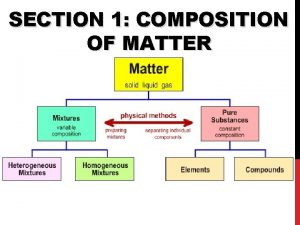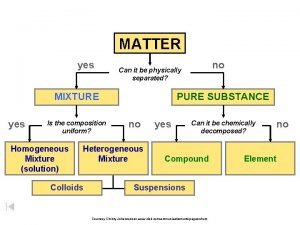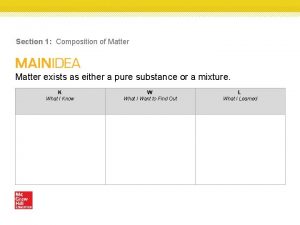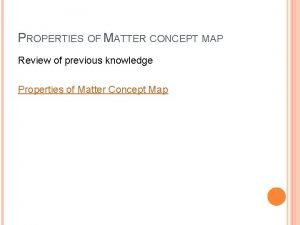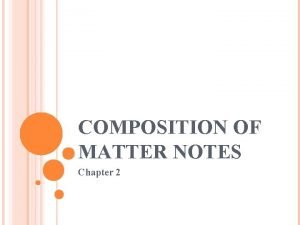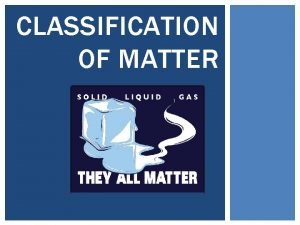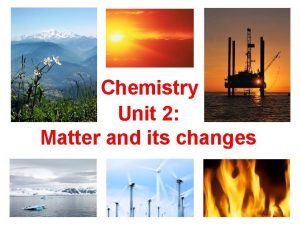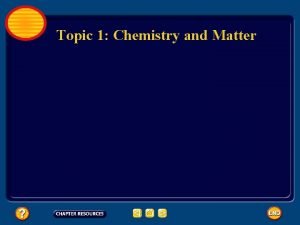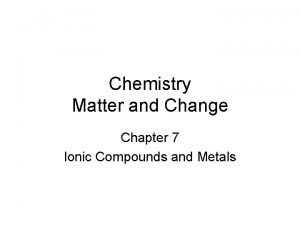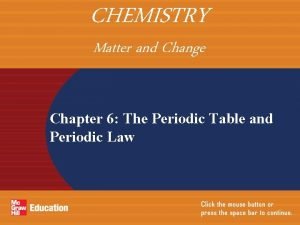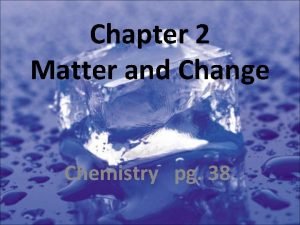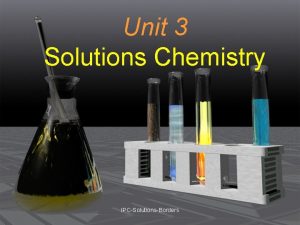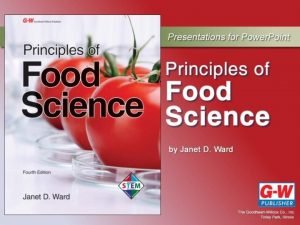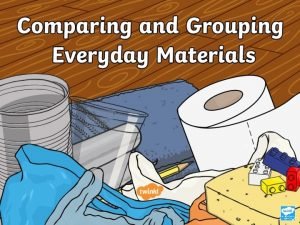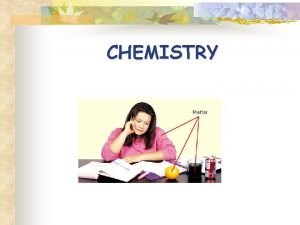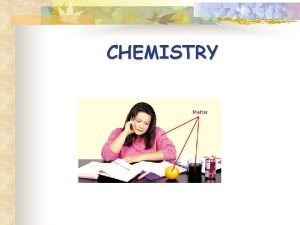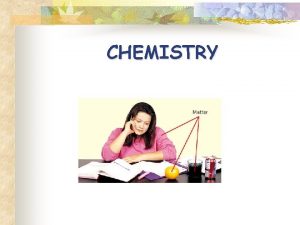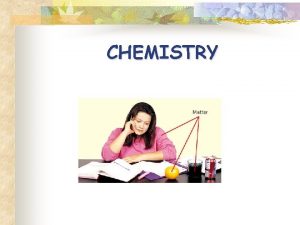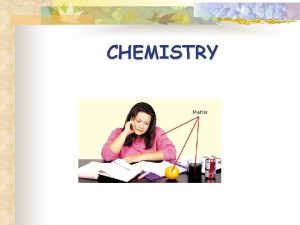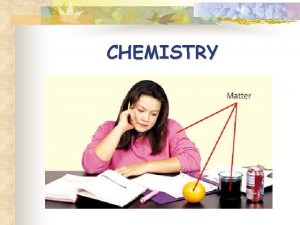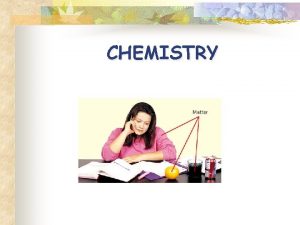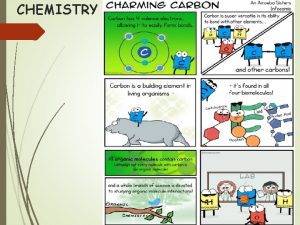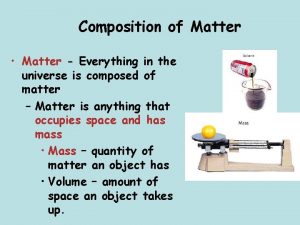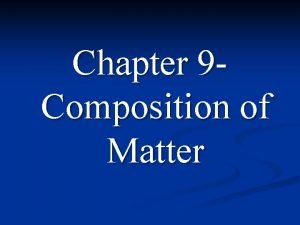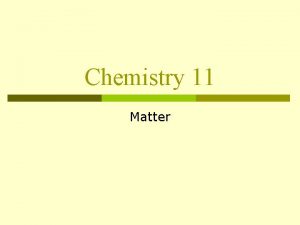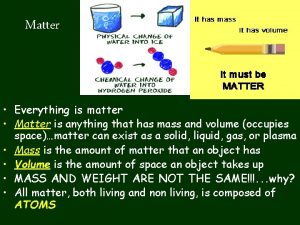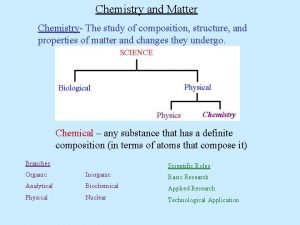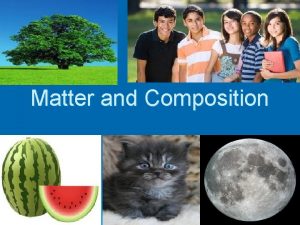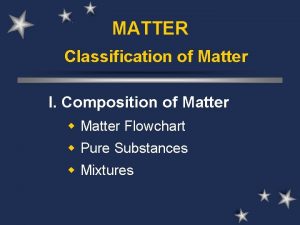CHEMISTRY Composition of Matter n Matter Everything in










































- Slides: 42

CHEMISTRY

Composition of Matter n Matter - Everything in universe is composed of matter n Matter is anything that occupies space or has mass n Mass – quantity of matter an object has n Weight – pull of gravity on an object

Elements n n Pure substances that cannot be broken down chemically into simpler kinds of matter More than 100 elements (92 naturally occurring)

n n 90% of the mass of an organism is composed of 4 elements (oxygen, carbon, hydrogen and nitrogen) Each element unique chemical symbol n Consists of 1 -2 letters n First letter is always capitalized

Atoms n n n The simplest particle of an element that retains all the properties of that element Properties of atoms determine the structure and properties of the matter they compose Our understanding of the structure of atoms based on scientific models, not observation

The Nucleus n n Central core Consists of positive charged protons and neutral neutrons Positively charged Contains most of the mass of the atom

The Protons n n n All atoms of a given element have the same number of protons Number of protons called the atomic number Number of protons balanced by an equal number of negatively charged electrons

The Neutrons n n The number varies slightly among atoms of the same element Different number of neutrons produces isotopes of the same element

Atomic Mass n n n Protons & neutrons are found in the nucleus of an atom Protons and neutrons each have a mass of 1 amu (atomic mass unit) The atomic mass of an atom is found by adding the number of protons & neutrons in an atom

The Electrons n n Negatively charged high energy particles with little or no mass Travel at very high speeds at various distances (energy levels) from the nucleus

Periodic Table n n n Elements are arranged by their atomic number on the Periodic Table The horizontal rows are called Periods & tell the number of energy levels Vertical groups are called Families & tell the outermost number of electrons


Compounds n n Most elements do not exist by themselves Readily combine with other elements in a predictable fashion

n n A compound is a pure substance made up of atoms of two or more elements n The proportion of atoms are always fixed Chemical formula shows the kind and proportion of atoms of each element that occurs in a particular compound

n n Molecules are the simplest part of a substance that retains all of the properties of the substance and exists in a free state Some molecules are large and complex

Chemical Formulas n n Subscript after a symbol tell the number of atoms of each element H 20 has 2 atoms of hydrogen & 1 atom of oxygen Coefficients before a formula tell the number of molecules 3 O 2 represents 3 molecules of oxygen or (3 x 2) or 6 atoms of oxygen

n The physical and chemical properties of a compound differ from the physical and chemical properties of the individual elements that compose it

n n Atoms that gain electrons are called negative ions Because positive and negative electrical charges attract each other ionic bonds form

Energy and Matter n Energy n The ability to do work or cause change n Occurs in various forms n Can be converted to another form n Forms important to biological systems are chemical, thermal, electrical and mechanical energy n Free energy is the energy in a system that is available for work

States of Matter n n Atoms are in constant motion The rate at which atoms or molecules in a substance move determines its state

n Solid n Molecules tightly linked together in a definite shape n Vibrate in place n Fixed volume and shape

n Liquids n Molecules not as tightly linked as a solid n Maintain fixed volume n Able to flow and conform to shape of container

n. Gas Molecules have little or no attraction to each other n Fill the volume of the occupied container n Move most rapidly n To cause a substance to change state, thermal energy (heat) must be added to or removed from a substance n

Energy Transfer n n n Much of the energy organisms need is provided by sugar (food) Undergoes a series of chemical reactions in which energy is released (cell respiration) The net release of free energy is called an exergonic (exothermic) reaction

n n n Reactions that involve a net absorption of free energy are called endergonic (endothermic) reactions Photosynthesis is an example Most reactions in living organisms are endergonic; therefore living organisms require a constant source of energy

n n Most chemical reactions require energy to begin The amount of energy needed to start the reaction is called activation energy

n n Certain chemical substances (catalysts) reduce the amount of activation energy required Biological catalysts are called enzymes

n Enzymes are an important class of catalysts in living organisms n Mostly protein n Thousands of different kinds n Each specific for a different chemical reaction

Enzyme Structure n n n Enzymes work on substances called substrates Substrates must fit into a place on an enzyme called the active site Enzymes are reusable!

Reduction-Oxidation Reactions n Many of the chemical reactions that help transfer energy in living organisms involve the transfer of electrons (reduction-oxidation = redox reactions)

n Oxidation reaction – reactant loses electron(s) becoming more positive

n Reduction reaction – reactant gains electron(s) becoming more negative

Solutions

Solutions n A solution is a mixture in which 2 or more substances are uniformly distributed in another substance

n n n Solute is the substance dissolved in the solution n Particles may be ions, atoms, or molecules Solvent is the substance in which the solute is dissolved Water is the universal solvent

Acids and Bases n One of the most important aspects of a living system is the degree of acidity or alkalinity

Acids n Number of hydronium ions in solutions is greater than the number of hydroxide ions n HCl H+ + Cl-

Bases n Number of hydroxide ions in solution is greater than the number of hydronium ions n Na. OH Na+ + OH-

p. H Scale n n logarithmic scale for comparing the relative concentrations of hydronium ions and hydroxide ions in a solution ranges from 0 to 14 § Each p. H is 10 X stronger than next § e. g. ph 1 is 10 times stronger than ph 2

n n n the lower the p. H the stronger the acid the higher the p. H the stronger the base p. H 7. 0 is neutral

Buffers n n Control of p. H is very important Most enzymes function only within a very narrow p. H Control is accomplished with buffers made by the body Buffers keep a neutral p. H (p. H 7)

n n Buffers neutralize small amounts of either an acid or base added to a solution Complex buffering systems maintain the p. H values of your body’s many fluids at normal and safe levels
 Section 1 composition of matter
Section 1 composition of matter Composition of matter section 1
Composition of matter section 1 Composition of matter section 1
Composition of matter section 1 What is everything around us made of
What is everything around us made of Percent composition examples
Percent composition examples Is the composition uniform?
Is the composition uniform? Composition of matter flow chart
Composition of matter flow chart Study of the composition structure and properties
Study of the composition structure and properties What is dissolution
What is dissolution Mixture is the composition uniform
Mixture is the composition uniform Flowchart of matter
Flowchart of matter What is composition in matter
What is composition in matter Section 1 composition of matter
Section 1 composition of matter Physical change concept map
Physical change concept map Composition of matter flow chart
Composition of matter flow chart Composition of matter notes
Composition of matter notes Matter and its composition
Matter and its composition A type of matter with a fixed composition
A type of matter with a fixed composition Functional groups ib chemistry
Functional groups ib chemistry Inorganic vs organic chemistry
Inorganic vs organic chemistry Chemistry matter and its changes
Chemistry matter and its changes Chemistry matter and change chapter 7
Chemistry matter and change chapter 7 Chapter 10 the mole study guide
Chapter 10 the mole study guide Examples of matter in chemistry
Examples of matter in chemistry 1s 22 s22 p63 s23 p64 s2
1s 22 s22 p63 s23 p64 s2 Chemistry matter and change chapter 6
Chemistry matter and change chapter 6 Chemistry matter and change chapter 10 the mole answer key
Chemistry matter and change chapter 10 the mole answer key 2 matter and change answer key
2 matter and change answer key Flowchart undissolved solids
Flowchart undissolved solids Chemistry matter graphic organizer
Chemistry matter graphic organizer Chapter 4 basic food chemistry the nature of matter
Chapter 4 basic food chemistry the nature of matter Chapter 4 basic food chemistry the nature of matter
Chapter 4 basic food chemistry the nature of matter Chapter 4 basic food chemistry the nature of matter
Chapter 4 basic food chemistry the nature of matter Koosha golmohammadi
Koosha golmohammadi Chapter 2 section 1 classifying matter answers
Chapter 2 section 1 classifying matter answers Dural septa
Dural septa Gray matter and white matter
Gray matter and white matter What is grey and white matter
What is grey and white matter Flow energy review
Flow energy review Everything around us is called
Everything around us is called Lord i lift everything to you
Lord i lift everything to you The cross changes everything
The cross changes everything What is the answer to life the universe and everything
What is the answer to life the universe and everything



